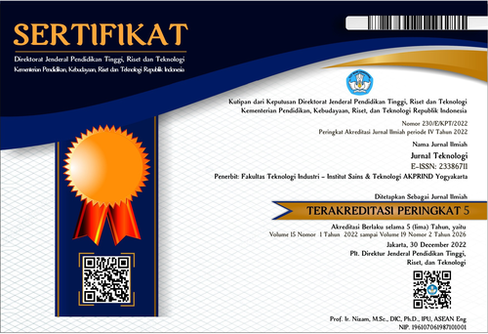Efektivitas Karbon Aktif Tempurung Kemiri Dalam Menurunkan Kadar Warna Naftol Merah Limbah Cair Industri Batik
DOI:
https://doi.org/10.34151/jurtek.v15i1.3985Keywords:
activated carbon, adsorption, batik waste, candlenut shellAbstract
The batik industry is one of the producers of pollution that can damage natural ecosystems. Batik industrial wastewater contains a lot of pollutants such as conductivity, BOD, COD, TSS, TDS, oil, pH. and temperature which are not suitable for the environment. In this study, the reduction of COD, BOD. and the concentration of red naphthol dye in the batik industry wastewater which was adsorbed with activated carbon of candlenut shell was studied. Batik wastewater is taken from Ngentakrejo Village, Kapanewon Lendah, Kulon Progo Regency. Candlenut shell activated carbon was obtained from pyrolysis, sieved with a pore size of 20 mesh, 40 mesh and 60 mesh and activated with NaCl solution whose concentration varied from 1.0; 1.5; 2.0; 2.5. and 3.0 M for 16 hours. Activated carbon was applied to adsorb red naphthol on batik wastewater by varying its weight at 10; 20; 30; 40. and 50 mg. The results showed that the effectiveness of candlenut shell- activated carbon to reduce red naphthol was 12.29%, BOD 25.49% and COD 26.67%. The adsorption process with activated carbon is not recommended as a sole treatment for batik industrial wastewater.
Downloads
References
Anonim, 2016. Peraturan Daerah Istimewa Yogyakarta Nomor 7 Tahun 2016 tentang Standar Baku Mutu Kegiatan Industri Batik
Auta, M. 2012. Fixed Bed Adsorption Studies Of Rhodamine B Dye Using. Journal of Engineering Research. 3, 3–6
Bansal, R. C. & GOYAL, M. 2005.Activated Carbon Adsorption. Taylor & Francis Group, Boca Raton
Bansode RR, Losso JN, Marshall WE, Rao RM, Portier RJ. 2004. Pecan Shell-Based Granular Activated Carbon For Treatment Of Chemical Oxygen Demand (COD) in Municipal Wastewater. Journal Bioresour Technology,.94(2):129–35.
Bukasa DA, Koleangan HS., Wuntu AD.2012. Adsorpsi Toluena Pada Arang Aktif Tempurung Kemiri. Jurnal Ilmu Sains;12(2):93
Chang, C. F., Chang, C. Y. & Tsai, W. T. 2000. Effects of burn-off and activation temperature on preparation of activated carbon from corn cob agrowaste by CO2 and steam. Journal of Colloid and Interface Sciencei. 232, 45–49.
Cheenmatchaya, A. & Kungwankunakorn, S. Preparation of Activated Carbon Derived from Rice Husk by Simple Carbonization and Chemical Activation for Using as Gasoline Adsorbent. International Journal of Environmental Science and Technology. 5, 171–175 (2014).
Gottipati, R. 2012.Preparation and Characterization of Microporous Activated Carbon from Biomass and its Application in the Removal of Chromium (VI) from Aqueous Phase, Department of Chemical Engineering. Dep. Chem. Eng. Natl. Inst. Technol. Rourkela Odisha, India 1–242
Hamu GV, Gauru I, Kadang L. 2019. Pemanfaatan Arang Aktif Tempurung Kemiri (Aleurites moluccana L. Willd) Sebagai Adsorben Zat Warna Naphtol. Jurnal Chemisry Notes.1(2):12–23.
Haryono, H., Faizal D, M., Liamita N, C. & Rostika, A. 2018. Pengolahan Limbah Zat Warna Tekstil Terdispersi dengan Metode Elektroflotasi. Jurnal EduChemia (Jurnal Kimia dan Pendidikan)) 3, 94.
Hendra D, Pangersa Gusti RE, Komarayati S.2014. Pemanfaatan Limbah Tempurung Kemiri Sunan (Aleuriteus Trisperma) Sebagai Bahan Baku Pada Pembuatan Arang Aktif. Jurnal Penelitian Hasil Hutan.;32(4):271–82..
Kurniawan, M. W., -, P. P. & -, S. S. 2014. Strategi Pengelolaan Air Limbah Sentra UMKM Batik Yang Berkelanjutan Di Kabupaten Sukoharjo. Jurnal Ilmu Lingkungan. 11, 62
Lellis, B., Fávaro-Polonio, C. Z., Pamphile, J. A. & Polonio, J. C. 2019. Effects of Textile Dyes on Health and The Environment and Bioremediation Potential Of Living Organisms. Biotechnology Research and Innovation Journal. 3, 275–290.
Liew Abdullah, A. G. et al. 2005. Azo Dye Removal By Adsorption Using Waste Biomass: Sugarcane Bagasse. International Journal of Engineering & Technology. 2, 8–13
Patil, D., Chavan, S. & Barkade, S. 2013.Production Of Activated Charcoal From Sugar Cane Leaves Using ZnCl2 Activation For The Adsorption Of Methylene Blue Dye. International Journal of Engineering Research & Technology, 2, 187–193
Rahayu, S. S., Astuti, S. & Budiarti, V. S. A. 2015. Rekayasa Pengolahan Limbah Cair Industri Kecil Batik Dengan Metode Elektrolisa. Pros. Sentin. 001, 267–276
Reinoso F R and Escribano A.S. 2001. Porous Carbons In Adsorption And Catalysis,. In: Nalwa HS, editor. Handbook of Surfaces and Interfaces of Materials. Academic Press,; 2001. p. 309–55.
Sandi A, - A. 2014. Pengaruh Waktu Aktivasi Menggunakan H3PO4 Terhadap Struktur Dan Ukuran Pori Karbon Berbasis Arang Tempurung Kemiri (Aleurites moluccana). J Fis Unand. 2014;3(2):115–20
Suek, J., Adar, D.,Wulakada, H and Keon, Y .2019. Kemiri, Komoditi Unggulan Di Kabupaten Manggarai Timur, Jurnal Berkala Epidemiologi, vol. 7, no. 02, pp. 204-211, Au..
Sulaiman NH, Malau LA, Lubis FH, Br Harahap N, Manalu FR, Kembaren A. 2018. Pengolahan Tempurung Kemiri Sebagai Karbon Aktif Dengan Variasi Aktivator Asam Fosfat. EINSTEIN e-JOURNAL. 2018;5(2).
Sumanjit, Walia, T. P. S. & Kansal, I. 2008. Removal of Rhodamine-B by Adsorption On Walnut Shell Charcoal. Journal of Surface Science and Technology. 24, 179–193.
Sunarsih,S. dan Dahani, W. 2018. Studi Adsorpsi Karbon Aktif Limbah Kulit Buah Nangka Terhadap Rhodamin B, Jurnal Teknologi, Vol. 11, no. 1, pp. 46–53.
Tahir, H., Sultan, M., Akhtar, N., Hameed, U. & Abid, T. 2016, Application Of Natural And Modified Sugar Cane Bagasse For The Removal Of Dye From Aqueous Solution. Journal of Saudi Chemical Society. 20, S115–S121.
Downloads
Published
How to Cite
Issue
Section
License
Copyright (c) 2022 Sri Sunarsih

This work is licensed under a Creative Commons Attribution 4.0 International License.
Jurnal Teknologi provides immediate open access to its content in order of making research freely available to the public to support a global exchange of knowledge. All articles published in this journal are free for everyone to read and download, under licence CC BY SA.
Benefits of open access for the author, include:
- Free access for all users worldwide.
- Authors retain copyright to their work.
- Increased visibility and readership.
- No spatial constraints.




















